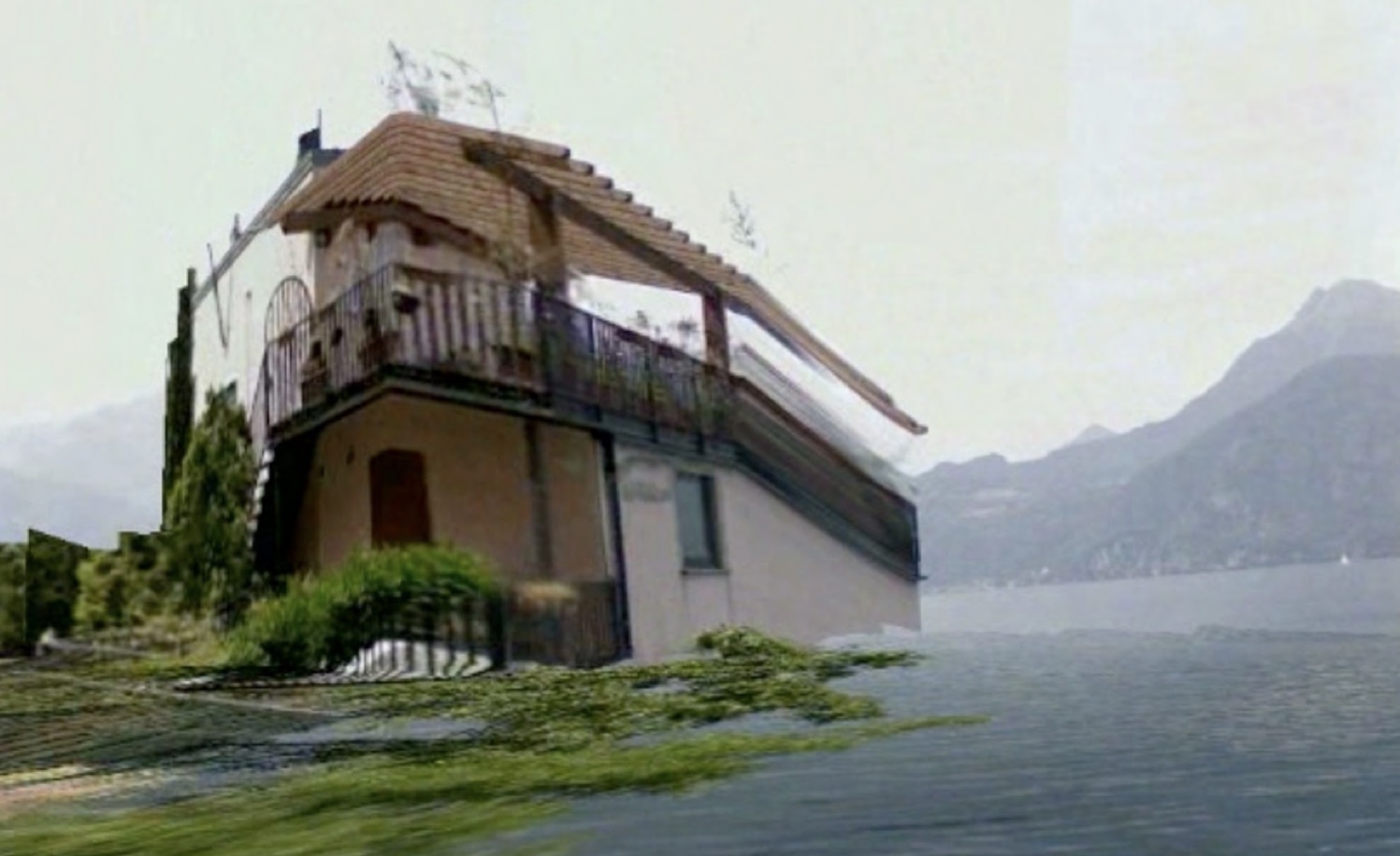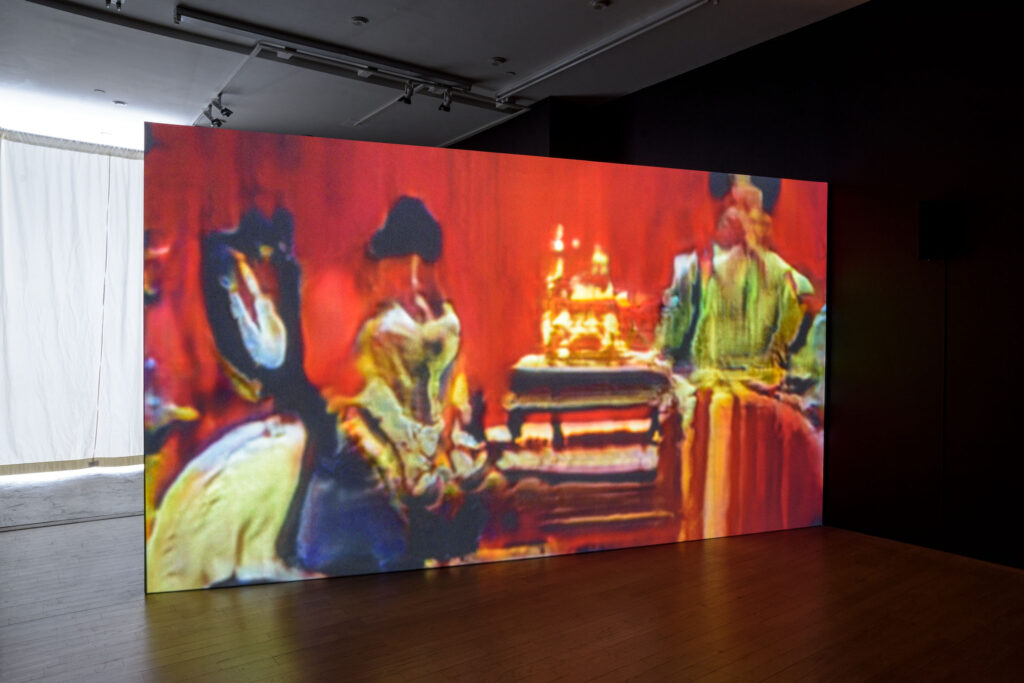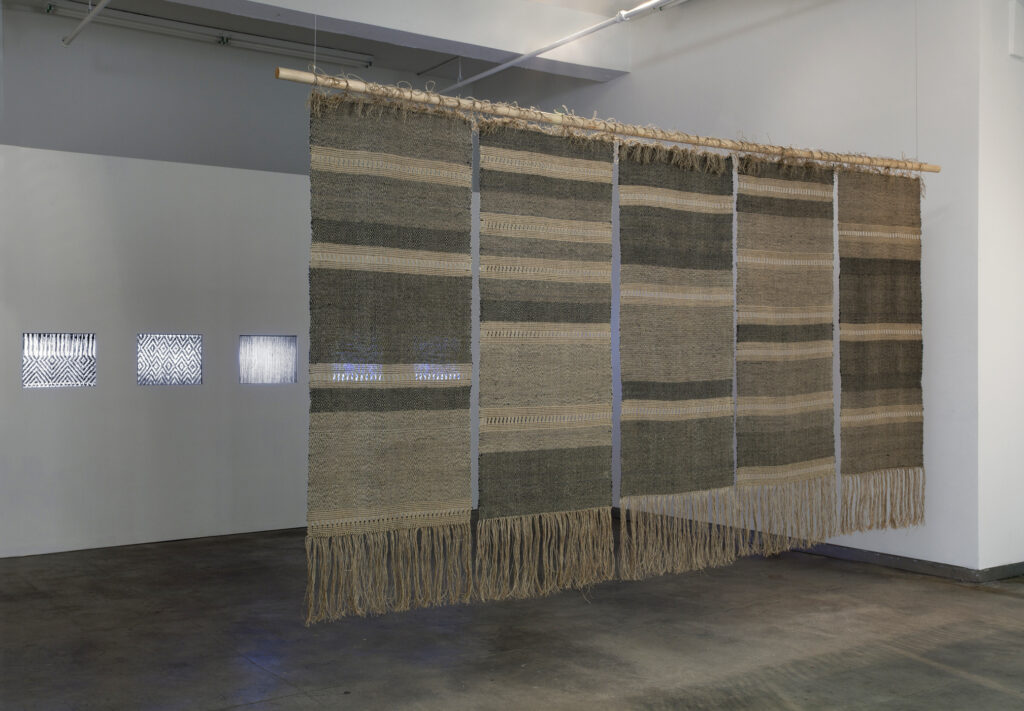Pau Waelder
Mark Amerika’s Museum of Glitch Aesthetics (MOGA), commissioned in 2012 by Abandon Normal Devices for the London Olympics, brings together a series of artworks created between 2005 and 2012 that explore the creative and aesthetic possibilities of glitch through various media. Amerika, with a group of collaborators that included Aaron Angello, Saoirse Crean, Mary Fé, Will Luers, Ruth McCullogh, Chad Mossholder, Julie Rooney, Rick Silva, Joel Swanson, and Steve Wade, among others, set up this fictional institution devoted to the work of The Artist 2.0, an equally fictional character whose oeuvre is profusely described and analyzed in a 73-page catalog that not only elaborates a complete profile of the artist, but also suggests critical reflections on digital culture, the IT industry, and the art world.
Ten years after its creation, MOGA comes to Niio in the form of a selection of six key artworks from the museum, and the following review of the work of The Artist 2.0, which participates in the fiction created by Mark Amerika and his collaborators.

Image compression
In 2005, The Artist 2.0 presented in an exhibition titled Pixelmash, in the Northwest of England, a series of animated GIFs, a (now lost) internet art work, and a digital video projection, all of which referred to the practice of appropriation and remix, so dear to early net art practitioners. The GIFs, part of the .gif(t) economy series (2005-2006), featured pixelated excerpts of early works of video art, photographs of pop stars, and paintings by Goya in dizzying loops that some would now identify as the work of a post-Internet artist or a cryptoart OG. These works already spoke of The Artist 2.0’s interest in the condition of the digital image in its online distribution: the image as a file that is constantly reused and re-contextualized, and more importantly, compressed.
Image compression formats were initially developed for the first digital cameras, but became crucial to the development of online content in the 1990s and have been popular ever since. Even recently, in 2021, Beeple’s infamous artwork Everydays: the first 5,000 days, which was sold at auction for $69.3 million, has been criticized for using the lossy compression format JPEG instead of the lossless PNG. While file formats can be said to have become part of our digital culture, they were particularly important for artists putting their work online in the 1990s, as they had to deal with the limitations of a 56kbps dial-up modem and create highly compressed images and 256-color animated GIFs. Pixelated images and fast-paced loops of grainy photographs or video sequences became an integral part of the aesthetics of early Internet art.
“I was one of the first artists of my generation who self-consciously bought a shitty mobile phone with first generation video recording technology embedded in it and just went, «Wow, that looks totally fucked up and I love it. This is better than painting.»”
The Artist 2.0
Before the dot-com bubble and the fascination for the new millennium brought a fleeting attention to Internet art that had major art institutions such as the Guggenheim Museum, the Whitney Museum of American Art, or TATE Modern acquiring web-based artworks, net art was identified with a renegade attitude towards the art world. It proclaimed the possibility of bypassing the gatekeepers and hierarchies of the art world 1.0 by using the web as an uncharted territory in which everything was possible and the roles of the actors could be reimagined. However, its proponents knew of the utopian nature of this proposition, as they knew that the art world 2.0 would still be ruled by institutions, corporations, and institutional corporations, and dominated by ever more sophisticated technologies and systems of data transmission. The pixelated image, in this sense, was also a form of rebellion, as well as a nostalgic reminder of a time when the resources were limited and the web was free, as in free speech and free beer.
Mobile Beach, 2007
Better than painting
It is believed that The Artist 2.0 studied art in the Northwest of England, probably at the Faculty of Arts and Social Sciences of the University of Lancaster. There he created his first mobile phone videos, taking images from his surroundings in industrial zones and the Morecambe bay, and posting photos in a primitive blog. Both the photos and videos presented glitches, consciously created by recording while performing violent movements or riding a vehicle, in order to overwhelm the device with too much data to process. The result, as can be seen in Mobile Beach (2007), presents interesting similarities with color field painting, which The Artist 2.0 surely noticed as they titled some of the photographs obtained with this technique “A Painting that Speaks for Itself.” The Artist 2.0 was also interested in linking these glitched images to street art, as can be seen in several photographs of walls, addressing a reiterated connection between digital art and street art as those rogue practices that do not have a place in mainstream contemporary art. “I was attracted to much lower tech versions of glitch before anyone was really paying attention to it,” states The Artist 2.0, asserting their pioneering role. “I was one of the first artists of my generation who self-consciously bought a shitty mobile phone with first generation video recording technology embedded in it and just went, «Wow, that looks totally fucked up and I love it. This is better than painting.»”
While The Artist 2.0 refers in this quote to the radical and controversial proposition of presenting a glitched image as equal or even superior to a color field painting, there is actually something more interesting taking place in the creation of glitch art. As philosopher Boris Groys once stated, a digital image does not exist by itself, but needs to be performed, to be seen, just as a musical score must be played to be heard. The image file contains information that the device interprets to display it as a visual output, and here Groys points out that “every performance is an interpretation and every interpretation is a betrayal, a misuse.” Therefore, the way we perceive digital images, as the equivalent of printed photographs, celluloid negatives, or paintings, is misleading. The digital image is always the result of an interpretation, and glitched images reveal this hidden truth. Ironically, in this manner the glitched photos taken by The Artist 2.0 do have a lot in common with color field painting, as both types of artworks deny the image its role as an illusory reality.
Lake District Walks: Code Mosh, 2007-2008
Walk the walk
The Lake District Walk series represents a later phase in The Artist 2.0’s work that stems from their early experiments with a shitty mobile phone. Here the mere recording of a video while walking in the countryside becomes an act of artistic creation as the device is once again overwhelmed by the amount of data to be processed, given the combination of movement and the varied and complex shapes that a natural environment has to offer. Several other elements come into play: the egocentric nature of recording an uneventful moment in one’s life, so much in line with the self-centered attitude that was starting to become the norm in early web 2.0 society; the first-person perspective, made popular by FPS video games; and finally the antagonistic relationship between nature and technology that has lead a growing segment of the world’s population to abandon the countryside and live in cities, where there is abundant wifi and plugs to charge their mobile devices, only to return during weekends to record boring videos and share them on social media.
“The flow of data, the water of information, is continuous, and I am a multilayered part of the mix. The flow does not ever really need me, but I totally need it. It roots me. It channels my creativity in ways I have no control over.”
The Artist 2.0
Videos like Lake District Walks: Code Mosh (2007-2008) illustrate this phase with a combination of the “color field painting” effect of previous works and a new and more interesting “dragging” effect which takes place when a camera movement forces the device to quickly refresh the image, resulting in a delay that has portions of it frozen and awkwardly dragged to a new position. This effect, crudely achieved in this manner, will inspire future generations of artists, such as Davide Quayola, who has achieved it in a controlled manner through sophisticated image recognition techniques. As will be discussed further, the Lake District walks are by no means a simple method to generate glitches through camera movements and a highly textured environment: the act of walking and the exploration of a non-urban space have a particular meaning that will be made apparent in The Artist 2.0’s later work.
It is worth mentioning in this phase a rara avis, a mysterious undated video whose authorship might be questioned, were it not for its undoubtable similarities with Mobile Beach and its clear influence in the following phases of The Artist 2.0’s oeuvre. Glitch Lake is a separate work that does not consist of recording a walk, but staying put while pointing the camera at a mass of water bathed in the afternoon sun. The gentle ripples caused by the waves and the scintillating reflection of the sun are enough to cause a wide variety of glitches in the otherwise static image. This is a smart move by The Artist 2.0, who finds out that it is not necessary to move the camera around. It is enough to choose a subject that is in constant motion, yet not changing its position: water becomes an ideal generator of glitched videos.
Glitch Lake
Dérives
Before we get to the title of this article, let’s take a detour, or better a dérive. The Artist 2.0 took a turn in his artistic research, caught by the unavoidable appeal that Google products have had on digital artists over the last two decades. Interested in the creative possibilities of Google Earth, he created several artworks, among which the popular Lake Como Remix (2012), a recording of a live VJ session in which The Artist 2.0 explored a road that runs along Lake Como in Italy, exploiting the glitches produced by their erratic navigation. In this virtual dérive, The Artist 2.0 enacts a “walk” in a virtual space composed of a 3D model mapped with photographs and drawn in real time by a software collecting data from the Internet. An obvious, and endless, source of glitches, it becomes an ideal tool for visual experimentation while suggesting a critique of the way our perception of the world is now mediated by the products of a large corporation. Unlike other artworks that address similar glitches, such as Clement Valla’s also widely popular Postcards from Google Earth (2010), the Lake Como video can be logically connected to the Situationists’ practice of dérive, which can be described as aimlessly walking through the city in order to understand its structure and “be drawn by the attractions of the terrain,” as Guy Debord would put it. The Artist 2.0 consciously goes in circles, explores the tunnels and abruptly turns the camera towards the lake to reveal the visual tricks created by the software and the fragile scaffolding on which the whole virtual environment depends.
Lake Como Remix, 2012
The importance of this dérive, or the act of moving, particularly when comparing this work to those of Valla and others, will be even more relevant in later works by The Artist 2.0. At this point, it is important to mention that Google Earth brings in an even more effective way of using the glitch to question the validity of the image as an illusion of reality. The landscape of Lake Como never succeeds in fooling the viewer: unlike previous videos in which a real image is glitched, here there is no reality to start with. “[T]he image never really has time to become an image in this environment,” states The Artist 2.0, “It’s more like what I call image information or visual codework. It’s something that’s always in process and always being processed by the receiver.” The Artist 2.0 forces Google Earth to veer off its path and participate in a dérive that will never take it to its intended destination. Lost in a cul-de-sac, the software reveals the process behind a simulation that has become powerless.
Disrupting flows
Glitch Lake had shown how water created glitches, but there was more to extract from the idea of flows. The HD Streaming series plays with the requirements of a high definition video, so common in our daily consumption of news and entertainment, which has in turn created the need for higher bandwidth connectivity, wherever we are. The videos are again captured in natural environments and in some cases streamed over the Internet from the mobile phone, conceptually connecting the water streams with the flows of data that enable reproducing the video somewhere else. The Water of Information (Data Flow Capture #36) is an outstanding example of this series: the camera is fixed on a small stream, water flowing down between ferns and bushes. The scene reminds of the view from a public webcam or the fake flowing river photographs one might encounter in certain restaurants. As a video, it is only interesting because the glitches caused by the water disrupt the whole image: it trembles and stretches, and at times it becomes a cascade of pixels, an abstract composition of vertical green lines. As The Artist 2.0 themselves put it, the concept of flow is central to their work: “The flow of data, the water of information, is continuous, and I am a multilayered part of the mix. The flow does not ever really need me, but I totally need it. It roots me. It channels my creativity in ways I have no control over.”
The Water of Information
Adrift in this flow, The Artist 2.0 escapes our gaze and his brief but seminal contribution to the History of Art in one last dérive. Circling back to their origins, The Artist 2.0 remixes a previous artwork, one of the Lake District Walks, which now appears in a split screen next to a virtual recreation of the same video, rendered in a 3D game engine. Titled Getting Lost (The Long Dérive) (2012) this last artwork is an obvious reference to the work of artist Richard Long and the Situationists, in what can be considered typical of a phase of maturity in an artist’s work, when one looks back at the old masters not to kill them, but to acknowledge them. Notably, in this artwork the video is not glitched: technology has now achieved a stable and reasonably well-defined moving image. It is, however, the 3D rendered space that is still glitchy, the camera movements causing a “dragging” effect of certain background elements and simulated objects. It seems, then, that The Artist 2.0 is suggesting that just as digital video has achieved the means to remain an illusion, so will virtual environments, which are currently suffering from a limitation of resources similar to that of online imagery in the 1990s.
Getting Lost (The Long Dérive), 2012
Getting Lost ends with the camera pointing towards a cloudy sky, as if searching for an answer or a way to continue wandering about. It may also hint at the metaverse, that ill-defined space or accumulation of spaces that seem to reside in the clouds, or nowhere. Notably, online virtual environments are also prone to glitches, as Gazira Babeli, the rogue Second Life performance artist, can attest. The Artist 2.0 has shown that our devices are shaping how we see the world, even before virtual and augmented reality turn real spaces into mere point clouds meant to be covered with perfectly rendered 3D illusions from which we cannot escape. But even then, there will be glitches, and the glitches will reveal the truth.
































